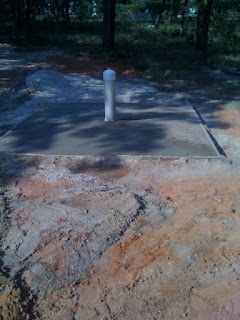Here's the drilling rig:
Not too big or a machine, but with all the equipment, fully capable of going down a very long ways. We had a couple of choices. Either a 5+" hole or an 8+" hole. A significant difference in diameter and also a difference in price with the larger hole costing about 50% more than the smaller. But would the smaller support not only the Barndaminium but another house or two plus the various things we want to do for the gardens? We even consulted a friend here in Australia who is in the irrigation business. His advice: drill the larger hole. So we did.
The first day, they created a slurry pit with this hole and a lot of water:
From what I've been told, part of that hole actually had a very large gopher hole within it, so pouring lots of water into the pit resulted in nothing but water going down the gopher hole. So they had to move a bit and create another slurry pit for the drilling.
After a number of hours, they had gotten down to 250'. Adjacent properties had their wells around 350' so we figured that the following morning, after a few hours, they'd be down to the desired depth and be able to add the gravel, screens and finish the top of the well and cap it.
Unfortunately, things didn't go according to plan. I've not been involved with drilling a well before. Anytime I've had a property with a well, we always bought the house with the well. But I've also heard that once you start drilling a well, you generally continue the work until you get to the desired depth, get the result you want and then do the finish work. Our driller didn't do that. Instead, he asked our family to keep some water running into the hole all night to keep things moist. And as those things usually go, the water got turned off and the well driller came on site the following morning to quite a mess. The hole had largely caved in and there was even some danger that the hole would swallow the drilling rig. That wouldn't have been very good.
After a number of hours, though, they recovered the work, got back to 250' and continued on through the following night until they got the result they wanted. It was probably a very long and tough night the second night but we got the result we wanted (mostly). Here's a picture of the finished well and then I'll have a few words about the aquifer in that part of the world.
The road in the middle is the little spur off the main road. Power on the right, water on the left. We'll build a nice shed on the slab around the water pipe with the pressure tank, pump and any other equipment. We'll also harvest water that comes off the large roof of the Barndaminium (and any other buildings we erect) to hopefully provide all of the water required for gardens. I would imagine we'll add the equipment and infrastructure to pump this water into this complex as well.
Now to the final comments from the driller. He said he hadn't drilled a well in this area for a couple of years. However, the last time he did one (within a mile), he got very good water at 350' and with a pipe of this size of ours, was quite able to sustain about 50 gallons per minute (gpm). He said that after the recent drought, he was able to get only about 15 gpm. That's a relatively disappointing amount of water. While it'll be adequate as we plan to use tanks and use the pump primarily to get water from the aquifer to the tanks, it is still cause for concern. The other comment the driller made was that he felt the real problem (in addition to the natural problem of the multi-year drought) was that the local peanut farmers were going down 700' with very large pumps and really sucking the aquifer dry in order to irrigate their peanuts. It's been a pet peeve of mine for years - the planting of water intensive crops in naturally dry areas. Generally done because there's an unusual source of water available which enables these crops (whether they be rice, cotton, citrus trees, nut trees, or peanuts) to be grown in an area where they should never be planted. All of these crops are grown in the San Joaquin Valley in California where we once lived because of the large irrigation canals that take water from the snow runoff of the Sierra Nevada mountains to Southern California. Rice and corn are also grown in some of the driest regions of Australia simply because there's a river nearby that can be tapped for water (much to the distress of other needs of the river).
But that's just my political rant of the day. What are your thoughts? Love to year them. Just put your comments here for all to see and comment further.




No comments:
Post a Comment